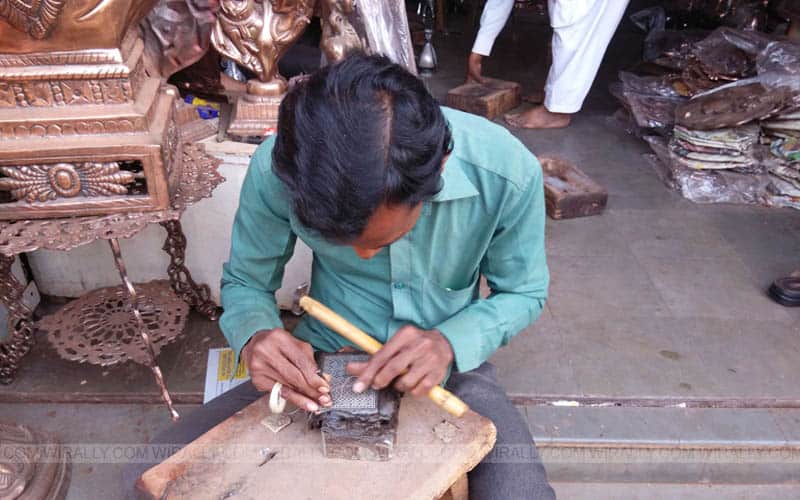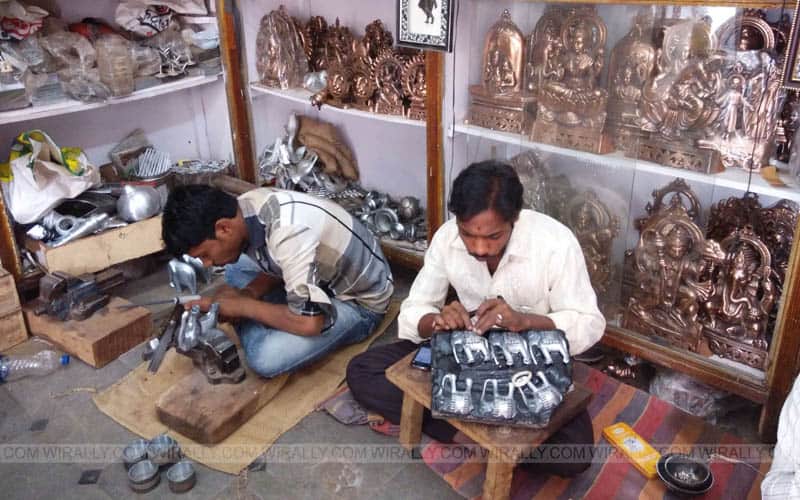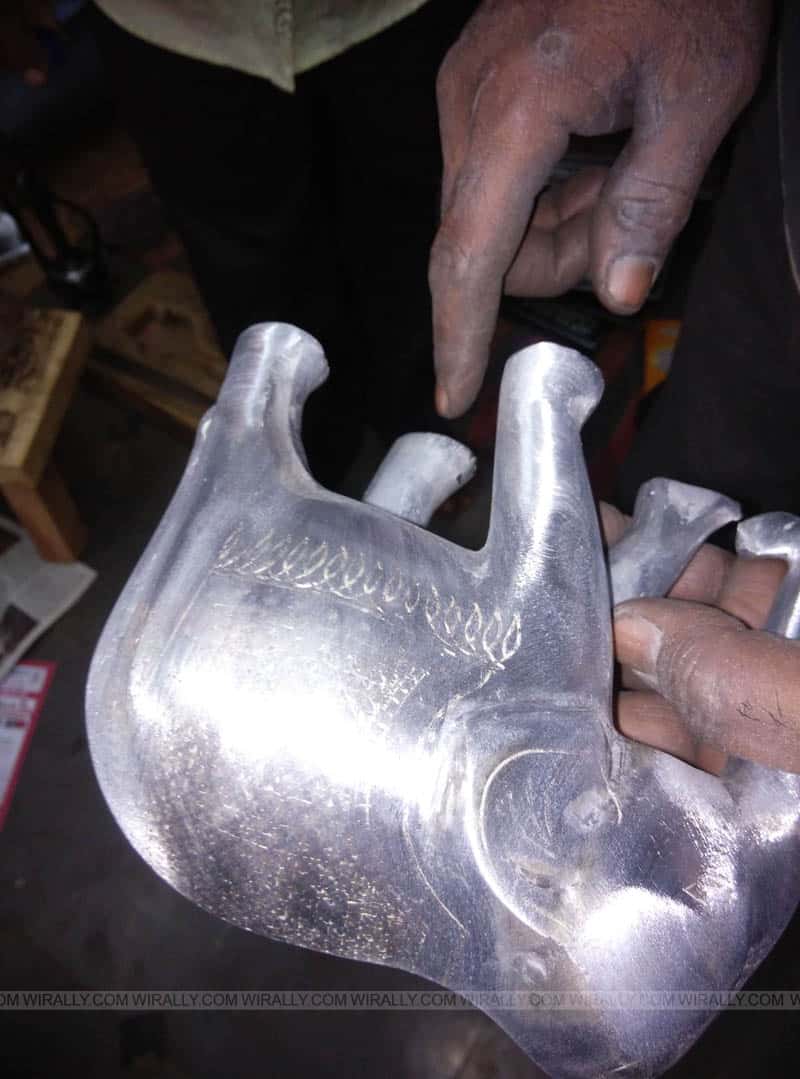By Surela Chakraborty
Bidar is a hill-top city that is located in the north-eastern part of Karnataka. It is 134 kilometers away from Hyderabad and it takes three hours to reach there. Though the lake is drying up still the scenic beauty makes it an idyllic weekend getaway. The weekend trip to Bidar would be incomplete without visiting shops selling Bidriware. After the visit to the Bidar fort we drove to the market place to watch artisans making the famous Bidriware. As we passed the clock tower and entered the Siddiq Sha Taleem Chowbara road, we found that it was lined with shops where master craftsmen were are at work with their hammer and chisel. What makes Bidriware so unique is the silver work that stands out against the matte-black finish of the Zinc-copper alloy. Though Bidri work can also be found in Lucknow (the art is known as ‘ZarBuland’), Murshidabad in Bengal and Purnia in Bihar (the art is known as ‘Gharki’), but the craftsmanship in Bidar is unparalleled and thus it has received a Geographical Indications (GI) registry. Bidriware is a 500 year old Persian craft but still it is a purely Indian innovation.Artisans today are giving this metal handicraft a modern twist to make it attractive to the present generation.

I went inside one of the shops to see what Bidriware actually looks like and find out how it is made. Entering one such workshop that came alive with the sound of the hammer, it was a delight to see the artisans working on the cast alloy pieces. I asked the artisan and shop owner Rajkumar Nageshwar to tell me more about this handicraft. He calls this craft a ‘black magic’ from Bidar because the alloy of zinc and copper is turned into a black metal after processing it. He explains us how Bidriware is made-

Bidriware is made from an alloy of copper and zinc (he kept the ratio as a trade secret) by the method of casting. Sometimes lead and other non-ferrous metals are added to this alloy. A mould is made from soil, castor oil and resin is added to the soil to make it malleable. The molten metal is poured into the mould to give it the desired shape and later the cast piece is smoothened by filing. Then the cast metal piece is coated with copper sulphate solution on which the craftsmen etch the design using metal stylus. After the designs are etched the object is attached securely to a vise so that the artisan can hammer the fine silver thread or strips into these etched or designed grooves. After the engraving process is done then the metal object is filed or buffed to remove the black coating. At this point the engraving is not very clear. For the final blackening process the cast metal objects which are still hotare rubbed with a paste made from water mixed with ammonium chloride and a special soil brought from Bidar fort. The paste gives the body of the metal the black colour while the silver engraving retains its original colour. The paste is then removed from the artifacts and the silver gleams and looks beautiful against the black background. The mystery is how the ancient artisans turned the metal to black. Did they have knowledge of chemistry which only the learned elite possessed at that time?

Another question that occurred to me was ‘what is so special about the soil of the Bidar fort?’ The soil of the Bidar fort has oxidizing properties. The soil is picked from the unlit portions of the fort which has no access to sunlight or where the rain cannot wet the soil. There are “soil tasters” who say this soil from the fort has a sharp taste. Some soil experts believe since there was a mint in the fort there is a possibility that the soil has a rich metallic composition. The soil is always tested by the experienced artisans before it is used for the blackening process.

The entire process right from casting to oxidation is done by hand. It is a painstaking process and no wonder the items showcased are so costly. Thus the skill of the artisan and his experience becomes handy. Rajkumar is a State award winning artist learned the art of Bidriware making from his father who in turn learnt it from his father. Thus the skill passes from one generation to another. He not only works and sells Bidriware in this Bidar colony, he visits other parts of the country to exhibit his Bidriware. This is not only his livelihood but a passion. As we were looking at various artifacts a craftsman came in with a basket full of casted metal elephants and other decorative pieces. He said that these are raw materials yet to undergo engraving and the blackening process. I could see that designs were already etched on them and now the engravers will have to hammer the silver strips into the etchings. The work is divided among moulder, designer, engraver and the inlay artist to make the otherwise time consuming process a little faster. Bidri making involves a special technology called ‘Damascening in silver’.
After having a close look at the artifacts and selecting my mementos I took a tour of the shop and noticed a board on the the entire step by step process of Bidriware making was given in a pictorial format. I took photographs of this board at the entranceand also of the artisans busy at their work. They didn’t lift up their heads but kept on working, their passion for their work was very inspiring.
As a student of history I was naturally inquisitive about the origins of this art. Bidriware has its origin in Iran but when it was brought to India by followers of Khwaja Moinuddin Chisti.In India the Bidriware intermingled with local styles and developed an unique style of its own. The word ‘Bidri’ comes from the word ‘Bidar’. Sultan Ahmed Shah Wali brought some skilled artisans from Iran to build the ‘ Rangin Mahal’ and also the other mahals at the Bidar fort. Among those artisans few of them could do beautiful inlay work with silver and gold. One of them was Abdullah bin Kaiser who was great at the inlay work which deeply impressed the Bahamani Sultan. After the fort was constructed he requested the artisans to stay back in India and practice this ‘Koftgari’ work (Bidriware was earlier known by this name). He started a training center at Bidar where master craftsmen taught novices and this how the art flourished with the help of royal patronage. Some of the artisans migrated to Hyderabad and Aurangabad and carried on the tradition of Bidri making. Bidri making was also encouraged by the Nizams of Hyderabad. Now Bidri making is a family business, not only local Muslim craftsmen are involved in this other sects in Bidar have also joined in Bidriware making.
Initially craftsmen use to engrave verses from Quran, Persian roses, vine creepers, flowers (Ashrafi-ki-booti), stylized Poppy plants etc. was etched. Some also etch figurines of God and humans. Earlier, Bidriware only included paan holders, hookahs, goblets, wine bottles and pieces of furniture. Now Bidri making has received an impetus from fashion and furniture designers. Modern connoisseurs of art also want to decorate their homes with the exotic Bidriware. Artisans now design office stationery like pen stands, envelope opener or paper cutter, key chains, cigar boxes and ashtray etc. to attract young buyers. There are keepsakes too like trinket boxes, beautiful ear rings and necklace and cufflinks and other interesting curios that instantly capture your attention. The contemporary twist makes this 500 years old Persian craft still relevant and attractive to the modern buyer. Honestly, as Rajkumar puts it down in his business card, it is an art that has been skillfully “crafted to captivate.”


















